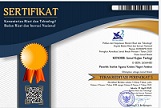Keselamatan bagi Tunas Liar?: Tafsiran Terhadap Alegori Keselamatan dalam Roma 11:17-24
Abstract
The concept of salvation that is unraveled in the New Testament is an interesting thing to analyze. Christians often use the concept of salvation to see a different world with their own identity. One of them is Romans 11:17-24, which speaks of salvation for both Gentiles and Jews. In this article, the text is analyzed descriptively, qualitatively. The findings of this study are: First, Israel’s refusal has resulted in the opening of salvation for people outside Israel. Second, the person who has been chosen to be saved must take responsibility for the choice, which is based on compassion and grace alone. Third, the form of safety response is an attitude of faith and obedience.
Abstrak
Konsep keselamatan yang terurai dalam Perjanjian Baru merupakan hal yang menarik untuk dianalisis. Kekristenan sering menggunakan konsep keselamatan untuk melihat dunia yang berbeda dengan identitas mereka sendiri. Salah satunya adalah teks Roma 11:17-24 yang berbicara tentang keselamatan bagi orang bukan Yahudi dan orang Yahudi. Dalam artikel ini, teks tersebut dianalisis secara deskriptif kualitatif dengan mempertimbangkan interpretasi gambaran visual dalam teks. Setelah dianalisis, maka ada beberapa hal yang ditemukan; Pertama, penolakan Israel mengakibatkan terbukanya keselamatan bagi orang di luar Israel. Kedua, orang yang telah dipilih untuk menjadi selamat harus bertanggung jawab atas pilihan, yang didasarkan pada belas kasih dan anugerah semata. Ketiga, bentuk respons keselamatan adalah sikap percaya dan taat.
Keywords
Full Text:
PDFReferences
Anderson, R. “Ancient Rhetorical Theory and Paul.†Theological Studies 59, no. 4 (1998): 760.
Banks, Marcus, and David Zeitlyn. Visual Methods in Social Research. Sage, 2015.
Barrett, Charles K. The Epistle to the Romans, Revised. Black’s New Testament Commentary. Peabody, Mass: Hendrickson Publishers, 1991.
Baxter, A G, and John A Ziesler. “Paul and Arboriculture: Romans 11.17-24.†Journal for the Study of the New Testament 7, no. 24 (1985): 25–32.
Davies, William D. Jewish and Pauline Studies. SPCK, 1984.
Dunn, James D G. Romans 9-16. Word Books, 1988.
Ellison, Henry L. The Mystery of Israel: An Expsition of Romans 9-11. Paternoster Press, 1976.
Ernst Kasemann. Commentary on Romans. Wm. B. Eerdmans Publishing, 1994. https://books.google.co.id/books/about/Commentary_on_Romans.html?id=537vyNBFfokC&redir_esc=y.
Esler, Philip F. “Ancient Oleiculture and Ethnic Differentiation: The Meaning of the Olive-Tree Image in Romans 11.†Journal for the Study of the New Testament 26, no. 1 (July 22, 2003): 103–24. https://doi.org/10.1177/0142064X0302600106.
Garroway, Joshua. Paul’s Gentile-Jews: Neither Jew nor Gentile, but Both. New York: Palgrave Macmillan, 2012.
Getty, Mary Ann. “Paul and the Salvation of Israel: A Perspective on Romans 9-11.†The Catholic Biblical Quarterly 50, no. 3 (1988): 456–69.
Gordon, Benjamin D. “On the Sanctity of Mixtures and Branches: Two Halakic Sayings in Romans 11:16-24.†Journal of Biblical Literature. Society of Biblical Literature, 2016. https://doi.org/10.15699/jbl.1352.2016.2783.
Hodge, Caroline Johnson. “‘A Light to the Nations’: The Role of Israel in Romans 9–11.†In Reading Paul’s Letter to the Romans, edited by Jerry L. Sumney, Vol. 73. Atlanta: Society of Biblical Literature, 2012.
Hultgren, Arland J. Paul’s Letter to the Romans: A Commentary. Wm. B. Eerdmans Publishing, 2011.
Jewett, Robert, Eldon Jay Epp, and Roy David Kotansky. Romans: A Commentary. Hermeneia. Minneapolis, MN: Fortress Press, 2006.
Karman, Yonky. Bunga Rampai Teologi Perjanjian Lama. Jakarta: BPK Gunung Mulia, 2015.
Moo, Douglas J. The Epistle to the Romans. New International Commentary on the New Testament. Grand Rapids, MI, USA: Eerdmans, 1996.
Schreiner, Thomas R. Romans. Vol. 6. Baker Academic, 1998.
DOI: https://doi.org/10.37196/kenosis.v1i1.286
Refbacks
- There are currently no refbacks.
Copyright (c) 2021 KENOSIS: Jurnal Kajian Teologi

This work is licensed under a Creative Commons Attribution-NonCommercial-ShareAlike 4.0 International License.
Jurnal Kenosis Telah Terdaftar Pada Situs:
This work is licensed under a
Creative Commons Attribution-ShareAlike 4.0 International License.
Copyright © Kenosis: Jurnal Kajian Teologi 2015-2022. All Rights Reserved.



